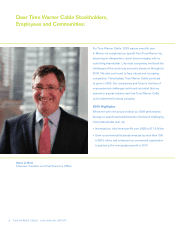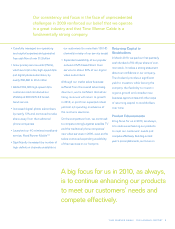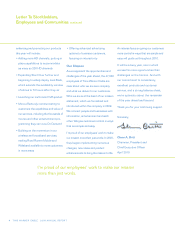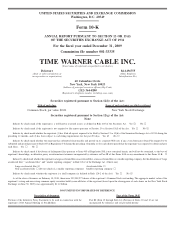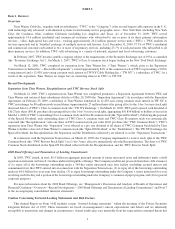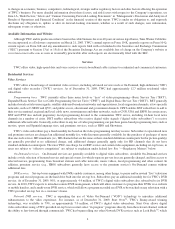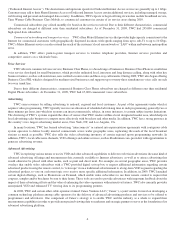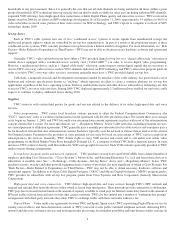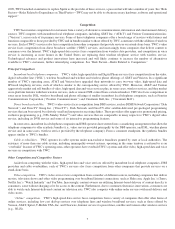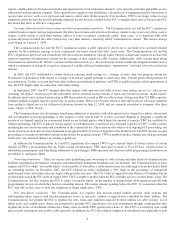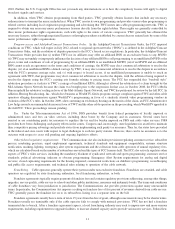Time Warner Cable 2009 Annual Report Download - page 13
Download and view the complete annual report
Please find page 13 of the 2009 Time Warner Cable annual report below. You can navigate through the pages in the report by either clicking on the pages listed below, or by using the keyword search tool below to find specific information within the annual report.PART I
Item 1. Business.
Overview
Time Warner Cable Inc. (together with its subsidiaries, “TWC” or the “Company”) is the second-largest cable operator in the U.S.,
with technologically advanced, well-clustered systems located mainly in five geographic areas – New York State (including New York
City), the Carolinas, Ohio, southern California (including Los Angeles) and Texas. As of December 31, 2009, TWC served
approximately 14.6 million residential and commercial customers who subscribed to one or more of its three primary subscription
services – video, high-speed data and voice – totaling approximately 26.4 million primary service units (“PSUs”). TWC markets its
services separately and in “bundled” packages of multiple services and features. As of December 31, 2009, 57.3% of TWC’s residential
and commercial customers subscribed to two or more of its primary services, including 23.7% of such customers who subscribed to all
three primary services. In addition, TWC sells advertising to a variety of national, regional and local advertising customers.
In February 2007, TWC became a public company subject to the requirements of the Securities Exchange Act of 1934, as amended
(the “Securities Exchange Act”). On March 1, 2007, TWC’s Class A common stock began trading on the New York Stock Exchange.
On March 12, 2009, TWC completed its separation from Time Warner Inc. (“Time Warner”), which, prior to the Separation
Transactions (as defined in “—Recent Developments”), owned approximately 84% of the common stock of TWC (representing a 90.6%
voting interest) and a 12.43% non-voting common stock interest in TW NY Cable Holding Inc. (“TW NY”), a subsidiary of TWC. As a
result of the separation, Time Warner no longer has an ownership interest in TWC or TW NY.
Recent Developments
Separation from Time Warner, Recapitalization and TWC Reverse Stock Split
On March 12, 2009, TWC’s separation from Time Warner was completed pursuant to a Separation Agreement between TWC and
Time Warner and certain of their subsidiaries dated as of May 20, 2008 (the “Separation Agreement”). In accordance with the Separation
Agreement, on February 25, 2009, a subsidiary of Time Warner transferred its 12.43% non-voting common stock interest in TW NY to
TWC in exchange for 80 million newly issued shares (approximately 27 million shares after giving effect to the 1-for-3 reverse stock split
discussed below) of TWC’s Class A common stock (the “TW NY Exchange”). On March 12, 2009, TWC paid a special cash dividend of
$10.27 per share ($30.81 per share after giving effect to the 1-for-3 reverse stock split, aggregating $10.856 billion) to holders of record on
March 11, 2009 of TWC’s outstanding Class A common stock and Class B common stock (the “Special Dividend”). Following the payment
of the Special Dividend, each outstanding share of TWC Class A common stock and TWC Class B common stock was automatically
converted (the “Recapitalization”) into one share of TWC common stock, par value $0.01 per share (the “TWC Common Stock”). TWC’s
separation from Time Warner (the “Separation”) was effected as a pro rata dividend of all shares of TWC Common Stock held by Time
Warner to holders of record of Time Warner’s common stock (the “Spin-Off Dividend” or the “Distribution”). The TW NY Exchange, the
Special Dividend, the Recapitalization, the Separation and the Distribution collectively are referred to as the “Separation Transactions.”
In connection with the Separation Transactions, on March 12, 2009, the Company implemented a reverse stock split of the TWC
Common Stock (the “TWC Reverse Stock Split”) at a 1-for-3 ratio, effective immediately after the Recapitalization. The shares of TWC
Common Stock distributed in the Spin-Off Dividend reflected both the Recapitalization and the TWC Reverse Stock Split.
2009 Bond Offerings and Termination of Lending Commitments
In 2009, TWC issued, in total, $6.5 billion in aggregate principal amount of senior unsecured notes and debentures under a shelf
registration statement on Form S-3 in three underwritten public offerings. The Company used the net proceeds from these debt issuances
(1) to repay all of the borrowings outstanding under a 364-day senior unsecured term loan facility (including accrued interest and
commitment fees) that TWC entered into in connection with the Separation Transactions, (2) to repay all of the borrowings outstanding
under its $4.0 billion five-year term loan facility, (3) to repay borrowings outstanding under the Company’s senior unsecured five-year
revolving credit facility and a portion of the borrowings outstanding under the Company’s commercial paper program, and (4) for general
corporate purposes.
For more information about the 2009 Bond Offerings, see “Management’s Discussion and Analysis of Results of Operations and
Financial Condition—Overview—Recent Developments—2009 Bond Offerings and Termination of Lending Commitments” and Note 7
to the accompanying consolidated financial statements.
Caution Concerning Forward-Looking Statements and Risk Factors
This Annual Report on Form 10-K includes certain “forward-looking statements” within the meaning of the Private Securities
Litigation Reform Act of 1995. These statements are based on management’s current expectations and beliefs and are inherently
susceptible to uncertainty and changes in circumstances. Actual results may vary materially from the expectations contained herein due
1



